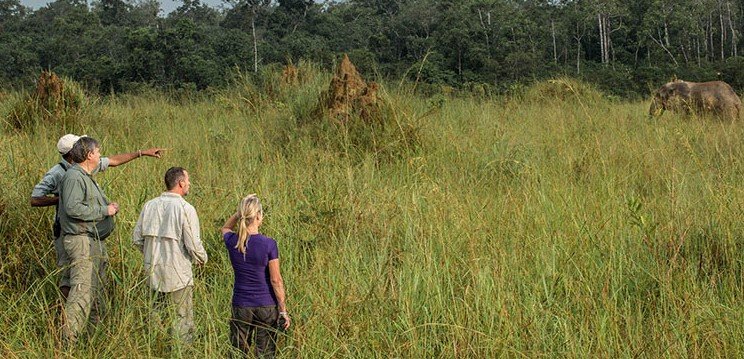How a 530-acre conservation park in rural Madison is winning hearts, headlines, and helping endangered animals thrive
Griff leans in gently, nostrils flaring as he crunches lettuce from a visitor’s hand. His eyelashes blink slow and serene, his patterned neck curling above a green Savannah that’s surprisingly not in Africa — but Georgia.
Less than 60 miles east of Atlanta, on a dusty road near the quiet town of Madison, the Georgia Safari Conservation Park has become a quiet giant in the world of wildlife conservation. Open for just over a year, the 530-acre preserve already feels timeless — like it’s been part of the landscape forever.
From Backyard Dream to Time Magazine Acclaim
What started as an ambitious idea a decade ago is now grabbing global attention.
The park’s founders spent nearly 10 years planning, fundraising, building partnerships, and preparing habitats before opening the gates to the public. In 2025, their efforts were recognized when Time Magazine named the park one of the “World’s Greatest Places.” And it’s not just for show.
Griff, a 17-foot-tall reticulated giraffe, lives among more than 40 species roaming semi-wild across open terrain — buffalo, rhinos, antelope, even the endangered addax. Each animal isn’t just a sight to see; they’re central to a growing mission.
This isn’t a zoo. There are no cages. No penguin exhibits. And no overpriced churros.
The Animals Have Names — And Stories
The first thing you notice on a guided safari tour? Everyone at the park talks about the animals like old friends.
One guide describes a sassy zebra who doesn’t like strangers. Another laughs about a grumpy buffalo named Frank who bullies the younger males. And then there’s Griff — calm, friendly, and apparently a bit of a flirt.
You learn quickly that each creature has its own space and its own pace. The park isn’t trying to entertain you. It’s trying to teach you — and maybe stir something deeper.
-
Frank the buffalo charges fence posts for fun
-
A shy kudu named Millie only comes out when the temperature’s just right
-
Rhinos, usually resting under trees, sometimes surprise guests by trotting right past the jeep
These aren’t animal facts from a brochure. These are personalities in motion.

A Conservation Mission Backed by Action
The park has a clear, almost stubborn focus on conservation. It’s not about photo ops or theme park rides.
Staff here are focused on breeding endangered species, giving them safe space to thrive, and preparing them — if possible — for eventual rewilding. That includes the critically endangered addax, a desert antelope whose wild population is estimated at fewer than 100 globally.
One zookeeper put it plainly: “If we don’t do this, they’re gone.”
Visitors learn more than just species names. They get the backstory — where these animals came from, what threatens them, and how everyday people might help.
Even the landscape was carefully planned. Each section of the property mimics the animal’s native environment as closely as possible, from tree types to grazing land.
Tourists, Teachers, and Second-Graders in Safari Hats
The Georgia Safari Conservation Park draws a strange and wonderful mix of visitors.
Some come because they saw a TikTok. Others are Atlanta families who want their kids to see animals without driving to Florida. School field trips are frequent — and they’re taken seriously.
One Tuesday in June, a second-grade class from Covington came through. The students wore paper safari hats and brought clipboards. Their teacher had them sketch each animal they saw and write down one interesting fact. One girl raised her hand and asked the guide, “Do giraffes have best friends?”
The guide paused, then smiled: “Griff kinda likes the ostriches. We’re still figuring it out.”
The park’s impact extends beyond its fences. Teachers leave with new lesson plans. Parents leave with kids asking questions. And the animals? They just keep doing their thing.
Admission, Hours, and What to Expect
While the park is still fairly new, it’s already well organized.
Here’s what visitors should know:
| Feature | Details |
|---|---|
| General Admission | $29 (Adults), $22 (Kids), Under 3 Free |
| Location | Madison, GA (1 hour east of Atlanta) |
| Safari Tour Length | ~1 hour guided tour by truck |
| Number of Species | 40+ |
| Park Size | 530 Acres |
| Opening Hours | 10 AM – 5 PM (Closed Tuesdays) |
You can’t drive your own car through the park. All tours are in open-air trucks driven by trained staff — who double as walking encyclopedias and amateur comedians.
Expect dust. Maybe a little giraffe drool. And a lot of smiles.
What Makes It Different (And Why It Works)
Plenty of places let you see exotic animals. Few let you feel like you’re part of something bigger.
The Georgia Safari Conservation Park works because it doesn’t feel transactional. You’re not paying to watch tricks or touch tiger cubs. You’re being invited into a space where the animals come first — and your curiosity comes second.
Also, they’re not trying to scale up too fast.
The staff limit how many tours run each day. They keep group sizes small. They refuse to open on Tuesdays — giving animals a “rest day,” and staff a breather. That kind of restraint is rare. And it’s paying off.
This park, for now at least, seems built to last.
